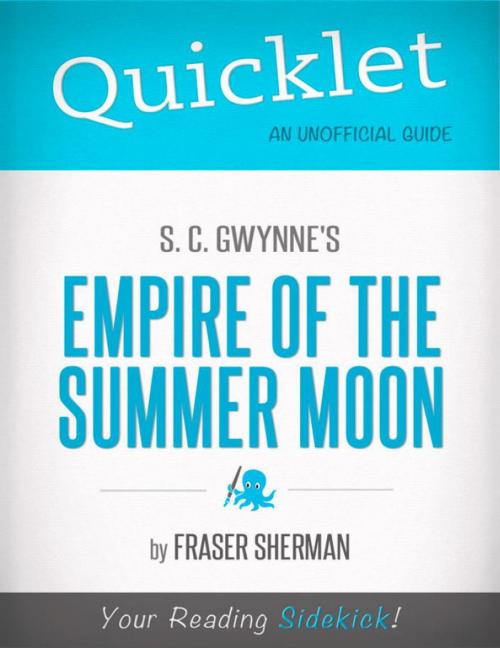Quicklet on S. C. Gwynne's Empire of the Summer Moon (CliffsNotes-like Book Summary)
Nonfiction, Reference & Language, Study Aids, Book Notes, Art & Architecture, General Art| Author: | Fraser Sherman | ISBN: | 9781614641735 |
| Publisher: | Hyperink | Publication: | February 29, 2012 |
| Imprint: | Hyperink | Language: | English |
| Author: | Fraser Sherman |
| ISBN: | 9781614641735 |
| Publisher: | Hyperink |
| Publication: | February 29, 2012 |
| Imprint: | Hyperink |
| Language: | English |
ABOUT THE BOOK
“It seemed implausible that the westward rush of Anglo-European civilization would stall in the prairies of central Texas.” – S.C. Gwynne, Empire of the Summer Moon
S.C. Gwynne first became interested in the Comanches while reading Walter Prescott Webb’s The Great Plains. Webb mentioned in one chapter that the Comanche tribes had been a barrier to white settlement, something Gwynne, a northerner, had never heard of. Intrigued, he began reading more books about the tribe, such as T.R. Fehrenbach’s Comanche: The Destruction of a People. After moving to Texas in the 1990s, Gwynne discovered that the Lone Star State still remembered the Indian Wars.
“A woman might tell me that her great-grandparents were both killed by Comanches,” Gwynne told the Historynet website. “This happened to me a lot.” (Interview with author S.C. Gwynne) Gwynne’s research convinced him there hadn’t been a significant book about the Comanches since Fehrenbach’s 1974 history. Having already written two nonfiction books, he decided to make the Comanches the subject of his third. He reasoned that if he found their history exciting and novel, other non-Texans, including New York editors, would have the same reaction. (Interview with author S. C. Gwynne)
MEET THE AUTHOR
Fraser Sherman was born in England and is now happily living in Durham, NC. He has 15 years experience as a reporter, 20 published fantasy/SF stories and is also the author of three film reference books.
EXCERPT FROM THE BOOK
They rejected conventional pitched battles in favor of the swift attacks the Comanche employed, and with this strategy won repeatedly. Over the next few decades, Texas forgot everything the Rangers had learned about Indian fighting. Texas and the United States fell back on traditional military tactics and peace negotiations. Negotiating with the Comanche never worked: the tribe’s warriors broke treaties and promises time and again, then came back and offered to renegotiate.
By the 1860s, cholera, smallpox and other European diseases had crippled many Comanche tribes. Nevertheless, the remaining tribesmen remained formidable and their attacks actually pushed the frontier back east. Then, the United States government decided to give up on negotiations. In 1871 Army sent Col Ranald Mackenzie, a Civil War veteran, to lead cavalry into the plains and hunt down the remaining Comanche. Over the next four years, Quanah Parker’s Indian warriors and Mackenzie’s troops clashed repeatedly, with the cavalry ultimately gaining the upper hand. Parker surrendered in 1875 – the Comanches’ days as buffalo hunters and raiders were over.
Parker adapted fast and well to civilization. Comanches had never cared for property, except horses, but Quanah Parker became a successful businessman and a prosperous landowner. Parker founded a school district for Comanche students. He also promoted the Peyote rituals that became the basis of the Native American Church. He died in 1911, of heart failure....
Buy a copy to keep reading!
ABOUT THE BOOK
“It seemed implausible that the westward rush of Anglo-European civilization would stall in the prairies of central Texas.” – S.C. Gwynne, Empire of the Summer Moon
S.C. Gwynne first became interested in the Comanches while reading Walter Prescott Webb’s The Great Plains. Webb mentioned in one chapter that the Comanche tribes had been a barrier to white settlement, something Gwynne, a northerner, had never heard of. Intrigued, he began reading more books about the tribe, such as T.R. Fehrenbach’s Comanche: The Destruction of a People. After moving to Texas in the 1990s, Gwynne discovered that the Lone Star State still remembered the Indian Wars.
“A woman might tell me that her great-grandparents were both killed by Comanches,” Gwynne told the Historynet website. “This happened to me a lot.” (Interview with author S.C. Gwynne) Gwynne’s research convinced him there hadn’t been a significant book about the Comanches since Fehrenbach’s 1974 history. Having already written two nonfiction books, he decided to make the Comanches the subject of his third. He reasoned that if he found their history exciting and novel, other non-Texans, including New York editors, would have the same reaction. (Interview with author S. C. Gwynne)
MEET THE AUTHOR
Fraser Sherman was born in England and is now happily living in Durham, NC. He has 15 years experience as a reporter, 20 published fantasy/SF stories and is also the author of three film reference books.
EXCERPT FROM THE BOOK
They rejected conventional pitched battles in favor of the swift attacks the Comanche employed, and with this strategy won repeatedly. Over the next few decades, Texas forgot everything the Rangers had learned about Indian fighting. Texas and the United States fell back on traditional military tactics and peace negotiations. Negotiating with the Comanche never worked: the tribe’s warriors broke treaties and promises time and again, then came back and offered to renegotiate.
By the 1860s, cholera, smallpox and other European diseases had crippled many Comanche tribes. Nevertheless, the remaining tribesmen remained formidable and their attacks actually pushed the frontier back east. Then, the United States government decided to give up on negotiations. In 1871 Army sent Col Ranald Mackenzie, a Civil War veteran, to lead cavalry into the plains and hunt down the remaining Comanche. Over the next four years, Quanah Parker’s Indian warriors and Mackenzie’s troops clashed repeatedly, with the cavalry ultimately gaining the upper hand. Parker surrendered in 1875 – the Comanches’ days as buffalo hunters and raiders were over.
Parker adapted fast and well to civilization. Comanches had never cared for property, except horses, but Quanah Parker became a successful businessman and a prosperous landowner. Parker founded a school district for Comanche students. He also promoted the Peyote rituals that became the basis of the Native American Church. He died in 1911, of heart failure....
Buy a copy to keep reading!















